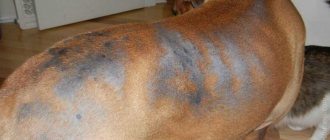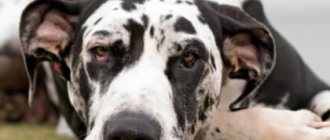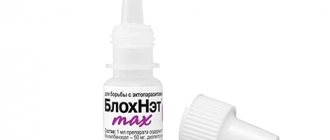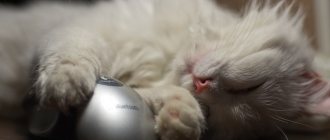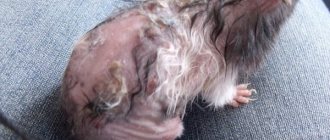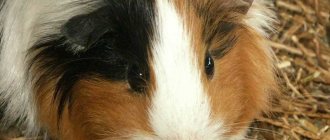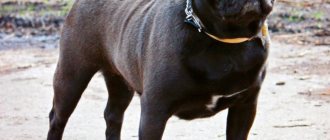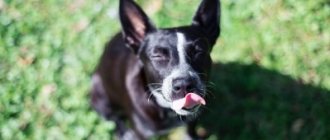The Pug is a short-haired dog breed and its coat is easy to care for.
But in order for it to look perfect, you should follow some rules regarding both coat care and general pet care.
In addition, the dog’s health also greatly affects the quality of its hair.
What should be the proper care for a pug’s fur and what should be done to ensure that your pet’s fur is always in perfect condition?
What does a healthy coat look like?
According to the requirements of the standard, a pug should have short, smooth and close-fitting hair that feels soft, delicate and quite thin to the touch.
The healthy coat of these dogs has a natural shine, most clearly visible in black pugs. The guard hair is short and soft enough, but not too light and blown by the wind.
Dark-colored dogs have less dense hair, but the hair is stiffer.
The pug's coat should be shiny, but not look greasy and feel oily to the touch..
What care is required?
There is an opinion that pug fur does not require any care.
But this is far from true, because it is not easy for the dog itself, with its short muzzle and stocky build, to take care of itself, which means that its owner has to do this.
In order for a pug's coat to look shiny, it needs to be properly cared for, with basic care coming down to regular brushing, bathing and, during the shedding period, removing dead hair using a furminator or a soft brush for shedding dogs..
In order to prevent dust, dirt and small debris from clinging to the animal’s fur during walks, before going outside it is better to put on a jumpsuit or other clothing that fits it in size.
Expert opinion
Kozhevin Semyon Kirillovich
Expert dog handler.
“Caring for a pug’s coat is not difficult, but it must be done regularly. Normally, your dog should be brushed with a natural bristle brush about once a week. During the shedding period, you should comb out dead hair daily with a special mitten for shedding dogs. You can also use a furminator, but it should be used less often: 2-3 times a week during molting and once every 2-3 weeks during normal times. Pugs are bathed infrequently and only when necessary, otherwise there is a risk of washing off the protective film from the coat and drying it out.”
Features of pug shedding
Despite the lack of fluffiness, pugs have very coarse hair and a dense undercoat. These small animals shed, like all dogs, twice a year, but sometimes unplanned shedding occurs. At the same time, the volume of wool combed out during hygiene procedures is quite large.
Important! Looking at the size of the animal, it is difficult to imagine that during molting it can lose such a volume of fur. At the same time, the pet does not look thinner or less attractive. This is how the pug’s body works.
This breed sheds twice a year. As a rule, this process begins in spring and autumn, when the climate changes. However, some factors, external or internal influences, can lead to a change in regime. So molting can begin in summer or winter, and also bother owners throughout the year. If you notice this phenomenon, it is better to consult a veterinarian.
Natural shedding
Usually, the loss of dead fur is painless for the animal and does not bring any inconvenience to it if the owner takes care of grooming the pet in a timely manner. Twice a year, in spring and autumn, during molting, you need to free the animal from old dead hair. Otherwise, your pet will not only look untidy, but also not feel its best. Old undercoat collects in tangles and creates a greenhouse effect, which is so harmful to pugs.
Natural shedding lasts approximately 2 – 3 weeks. The duration of this process depends on the color of the animal. Thus, pets of the “fawn” color shed less than their apricot-colored relatives. In the latter, molting continues almost all year round, and this is not a pathology. Their fur is genetically predisposed to die off at this rate.
Pathological hair loss
There are a number of diseases and disorders in a dog’s body that can cause severe and constant shedding. That is why pet owners should pay attention to such signs and promptly consult a veterinarian.
Among the main causes of excessive hair loss are:
- stress (this could be a simple visit to animal clinics or fear of something);
- parasites (some protozoa and worms can cause profuse, almost continuous molting);
- fungi and infections (excessive hair loss may indicate a fungal infection, you should immediately consult a veterinarian);
- too frequent washing (the use of cosmetics leads to active work of the sebaceous glands, this contributes to the accelerated death of the undercoat);
- incorrect climate (if the apartment where the pet lives is too hot, this can lead to pathological molting);
- lack of vitamins (this phenomenon is usually observed in animals that eat natural food; pets that eat dry balanced food do not suffer from this disease).
Important! Often a dog's tendency to allergies is also accompanied by hair loss. Especially if a cunning animal often eats something that should not be in its diet.
If you notice extensive loss of undercoat, which practically does not stop in your domestic dog, it is better to consult a doctor. Having passed the necessary tests and received the results, it will be possible to exclude a number of diseases that can lead to this.
Causes of severe shedding
Sometimes it happens that the dog begins to shed heavily or, even worse, the shedding began outside of normal hours.
Dogs can lose hair for a variety of reasons, the most common of which are::
- Improper maintenance and care.
- Unbalanced diet.
- Health problems: allergies, dermatitis, other skin ailments, as well as various diseases that affect the general health of the animal, including the quality of its coat.
- Hormonal imbalances.
- Stressful situations.
- Age-related changes. For example, puppies may begin to change their "baby" coat to a "adult" coat before or after the shedding season, and this is completely normal.
- Often the coat is completely or almost completely replaced in bitches that have carried and nursed another litter.
- External parasites.
Excessive shedding, especially if it began suddenly in winter or summer, may be one of the first signs of serious health problems for your pet..
Natural causes, duration
Shedding is a normal process for any dog that has at least some hair. And if you are a truly loving “parent”, it’s better to just get used to it. As for pugs. Pugs of fawn color lose hair less, this is due to the presence of a second undercoat. The fawn pug's undercoat is constantly growing, pushing out old hairs, so their shedding practically never stops.
Important! If the dog leads a reclusive lifestyle and spends little time outside the house, the fur marks will be very noticeable.
Like many dogs with short hair, pugs shed seasonally. It occurs 2 times a year, lasts about 2-3 weeks. In addition to this, there are 2 more options for natural hair loss: age-related shedding and shedding after completion of lactation in bitches.
Seasonal molt
During autumn and spring seasonal weather changes, the pug's fur falls out and its structure changes. Owners of apartment dogs often note a shift in shedding towards the summer and winter periods. This happens because it is difficult for a dog living indoors to navigate weather changes, since the conditions in the apartment are always favorable.
Age-related molting
6 weeks after the puppies are born, their delicate, original coat changes, and along with it, possibly, color. The stage of the first serious shedding occurs after the puppy reaches 6 months. At this stage, the first soft coat is completely replaced by a coarser, adult coat.
Shedding in bitches during the end of lactation
When the process of feeding the puppies comes to an end, the dog's fur begins to fall off again. If the losses are minor, do not worry too much; such molting does not require additional intervention. If too many puppies were born or the dog’s diet was not sufficiently balanced, foods containing vitamins A and B, for example, fish, should be added to the animal’s diet.
Having this data, you can approximately calculate the estimated time of the animal's planned molting.
Important! In order for the process to proceed under the motto “minimum costs,” feed your pet with general strengthening vitamins in advance.
There is no need to resort to specialized vitamins for wool. They often cause the fur to become fluffy, which spoils its overall appearance, and also puts additional strain on the kidneys.
- To reduce the spread of hair throughout the apartment, you need to comb your pet daily with a special brush, not missing the slightest area from the head to the tip of the tail. It is better to do this on the street or on a bare floor without carpets in order to easily remove the consequences of combing. Also an effective anti-shedding remedy is a furminator, also known as a trimmer. With its help, you can remove dying hairs before they get on furniture and textiles. Don't forget about room hygiene. Daily vacuuming (possibly in the car) should become ritual number one.
- Some experts claim that adding flaxseed oil or hemp acid will help the pug keep his wonderful coat intact. The thing is that pets are not able to produce these fatty acids on their own, which are so important for the health of their skin and coat. You can buy such products at any pet store.
What to do if your pet begins to shed heavily?
The first thing you should do when heavy shedding begins is to show your pet to a veterinarian.
If during the examination any health problems are discovered, treatment should be started immediately..
If it turns out that the problem is due to improper feeding, then you need to try to make the pug’s diet more complete and varied: increase the amount of foods that have a positive effect on the condition of the coat, such as vegetable oils and fresh vegetables and fruits.
It is also useful to start adding special supplements to the food to improve the quality of the coat.
CAREFULLY!
It happens that the cause of excessive shedding may be incorrectly selected store-bought food.
In this case, you can recommend trying to change the brand of industrial food or even switch your pet to natural feeding.
It may also make sense to change your shampoo and other grooming products. The same applies to incorrectly selected brushes and combs: they need to be replaced with others suitable specifically for pugs.
In case of severe shedding and even focal hair loss, self-medication is unacceptable: all ointments, shampoos and vaccines should be used only on the recommendation of a veterinarian after a full medical examination has been carried out.
Why does a pug shed in winter?
Each pug has its own uniqueness.
He can be stubborn when he is required to obey. The pug gets along well and gets along with children. True, he quickly gets bored with outdoor games in which he needs to run and jump, and he simply falls asleep on the go, with his tongue hanging out of his mouth, which simply does not fit there. By the way, the pug’s health is fine. One of the most common problems is obesity. Because pugs love to overeat. But with molting they have a complete mess and even a whole disaster.
Pugs shed all year round. True, there is a break of a couple of weeks, but just during this couple of weeks you will have swept out all the wool, the time will come when a new one, fresh, so to speak, will begin to appear.
Despite the fact that the hair of this breed is short, it is quite thick and its continuous shedding sometimes just drives them crazy. Just don’t take it out on the dogs, they certainly have nothing to do with it. You had to read and think when you purchased it.
There is one good solution to permanently get rid of pug shedding and that is grooming. Yes, we heard right, pug grooming will help you get your apartment in order.
When a pug sheds, yes all the time. Why does a pug shed a lot, yes because there are many reasons. But these are all unclear and general answers; in fact, there is another answer to why a pug sheds a lot.
The pug sheds heavily not only during the seasons, there are other reasons for it, for example, poor diet, lack of vitamins. Some will say that these are the most common habits and properties of any breed, but this is not so.
Even if you start giving vitamins and switch to proper nutrition, the shedding will not stop. Any crumbs from the kitchen floor will again resume the pug's shedding. A grandmother she knows said that she boils eggs twice a week, buys cottage cheese, makes porridge, but the pug still sheds and, consoling herself, says, “It’s good, even if I can’t see well, I can only imagine how much wool there is.”
But, I want to console the young owners of this cute breed of dog, by the age of three, shedding still decreases.
Not only do the digestive system and thyroid gland contribute to shedding, but the weather can also be deceiving. What dog owners call deceptive weather is the apartment where their pet is kept and the conditions.
Look, the cold weather has arrived, and then winter with frosts, the pug, like any other animal, should change clothes, but why, he lives in an apartment and is warm, but nature takes its toll and this causes the pug’s shedding to last up to 3 - x months.
And, as you know, winter only has three months, so he sheds all winter, which makes dog owners not happy at all.
And, as you know, winter only has three months, so he sheds all winter, which makes dog owners not happy at all.
Your beloved pug is shedding, and this becomes an insurmountable problem for many owners. Like many short-haired dogs, pugs shed seasonally. This happens about 2 times a year and lasts about 2-3 weeks. There are also such options for normal molting:
- depending on age;
- in bitches during the end of lactation.
How does age-related molting occur and what are its features? 6 weeks after birth, the first delicate coat of pugs changes, and with it the color. Dark lumps lighten and approach beige and apricot shades. At the next stage, which usually occurs after 6 months, the pug sheds heavily because the entire coat is replaced by a coarse, dense adult coat.
During seasonal changes in spring and autumn, the pug's hair falls out, and the undercoat and a little hair change. It is not easy for apartment dogs to navigate the changing seasons and the surrounding temperature; for them it is always comfortable. For this reason, owners of some animals note a shift in shedding between summer and winter.
When a dog is nursing its offspring or is approaching the end of lactation, it will experience a slight process of hair loss. If the shedding is not too abundant, then there is no point in focusing on the essence of the problem. But if the litter was large or the diet was unbalanced, then the inclusion of vitamins A and B and fatty acids will be necessary. When using natural food, add fish to the diet.
If you think your pug will be shedding soon, feed him general vitamins. This will help reduce the amount of shedding. Specialized vitamins for fur should not be given to pugs; they make the fur more fluffy, which spoils the appearance. From such vitamins, the animal’s kidneys receive additional stress, and the urine turns bright color.
The most effective and proven remedy for when a pug sheds is a furminator, also known as a trimmer. This special brush-comb will help pug owners get rid of dying undercoat. And this will lead to a decrease in the amount of wool that you are used to finding in your home and on your clothes. Try not to use this device more than twice a week.
Now let’s think about what to do if a pug sheds out of season and out of age, but constantly. Usually, the owner is to blame, who does not like the smell or dirt and constantly washes the animal, violating the skin and special lubricant. The permissible washing rate is once a month, and if possible, less often. The smell of the four-legged dog appears due to increased production of the sebaceous glands.
Another reason for hair loss may be inappropriate indoor temperature. Pugs feel comfortable at 26 degrees or below, but not around 30. Delayed deworming is a common cause of many coat problems. Diseases of the liver and biliary tract, pancreatitis in dogs are associated with fur and skin, and this can be determined by blood tests.
A critical deficiency of vitamins also leads to shedding, this often happens in dogs on natural food. Premium and super food contain a selected complex of vitamins; other animals need to include it additionally, especially puppies during the growth period. Adult pets also need vitamins; they improve the condition of all organs and have a great effect on well-being.
If you find an error, please highlight a piece of text and press Ctrl Enter.
The first thing you should do when heavy shedding begins is to show your pet to a veterinarian.
If during the examination any health problems are discovered, treatment should be started immediately.
If it turns out that the problem is due to improper feeding, then you need to try to make the pug’s diet more complete and varied: increase the amount of foods that have a positive effect on the condition of the coat, such as vegetable oils and fresh vegetables and fruits.
It is also useful to start adding special supplements to the food to improve the quality of the coat.
CAREFULLY!
It happens that the cause of excessive shedding may be incorrectly selected store-bought food.
In this case, you can recommend trying to change the brand of industrial food or even switch your pet to natural feeding.
It may also make sense to change your shampoo and other grooming products. The same applies to incorrectly selected brushes and combs: they need to be replaced with others suitable specifically for pugs.
In case of severe shedding and even focal hair loss, self-medication is unacceptable: all ointments, shampoos and vaccines should be used only on the recommendation of a veterinarian after a full medical examination has been carried out.
How to bathe correctly and what products to use
You can bathe pugs no more than once a month, but in general, it is better not to do this unless necessary, since any detergent, even one specifically designed for animals and at the same time the most gentle, washes away the protective fatty film that covers every hair of the dog’s fur.
If it is possible to get by with partial washing of dirty areas or washing without soap, then you should not neglect it: bathing in plain water does not degrease and dry the coat as much as washing with soap or shampoo.
In order to wash a pug, you need to put it in a bathtub or other large enough container, wet its fur with water and, if necessary, lather it with a special shampoo.
After washing the contaminated areas, the detergent should be rinsed off thoroughly and the dog should be rinsed, since soap remaining on the skin can cause irritation.
After bathing your pug, it is recommended to thoroughly wipe and dry its fur..
If the dog needs to be washed with soap, preference should be given to special hypoallergenic products intended for dogs.
IMPORTANT!
You should not bathe pugs with human shampoos, especially those with the addition of oils from exotic plants: such detergents can cause severe allergies in pugs.
As a last resort, if there is no shampoo for dogs, and you need to wash your pet urgently, you can use baby liquid soap, bathing gel or shampoo intended for newborns.
Why in bitches during the end of lactation?
It is completely normal if, in this case, the dog begins to shed again. This happens for the reason that, being lactating, the bitch’s level of vitamins in the body decreases. You should worry if the shedding is on a larger scale, this indicates that the dog is not eating balanced food, that is, in an inappropriate way.
Her diet should be reconsidered. In such situations, it is recommended to add products of animal origin containing vitamins of categories A and B. Or, after consulting with a specialist, buy vitamins intended for dogs at a veterinary pharmacy.
How to comb?
The pug's coat should be carefully combed with a metal comb with fine rounded pet teeth. In normal times, this procedure should be done once a week, during molting - daily.
The coat should be combed in the direction of hair growth . Combing movements should be smooth, but at the same time confident.
Do not run a comb over the animal's skin, as there is a risk of scratching it.
Usually dogs of this breed are not cut, but if the hair is a little bristly in some places, you can put it in order by trimming it with scissors or a clipper..
This will help create a clear silhouette and give the pet a beautiful and well-groomed appearance.
How to get rid of it?
If your dog sheds unscheduled:
- bathe your dog less often using detergents;
- adjust nutrition;
- exclude the presence of parasites – worms, fungus, skin mites, etc.;
- Contact your veterinarian and take a general blood test to rule out liver and pancreas diseases.
If a planned shedding is expected, give your pet a general vitamin complex in advance, which will help get out of this condition with minimal losses. As a rule, special vitamins for pugs’ fur are not suitable; they make the animal’s fur fluffy and its appearance noticeably deteriorates.
A powerful tool to reduce the amount of wool in the house is the furminator. This is a special device in the form of a brush-comb. Its regular use will effectively remove the dog's dying undercoat.
Using a furminator
Furminator will help solve the problem of shedding in pugs, when dead fur sticks to furniture, clothes and other household items.
This tool, which looks like a small rake and, in fact, is an improved version of a comb for dogs, will help get rid of dead, but lingering undercoat in the fur, without affecting or damaging the coat..
For pugs, small furminators are suitable, designed for short-haired medium-sized dogs, with a working surface length of approximately 4-5 cm and fairly short teeth.
When choosing a furminator for a pug, you should give preference to products from well-known companies rather than their cheaper and, often, lower quality analogues.
You need to use the furminator in the same way as a regular comb: calmly and slowly, without pressure or jerky movements, comb your pug with it, which it is advisable to wash and dry before using this tool, and clean and disassemble all places with tangled or matted hair by hand or with using a regular comb.
It is unacceptable to pull the furminator or try to comb matted fur with it: this not only causes discomfort to the pet, but can also lead to damage and breakage of the tool..
Grooming
A wonderful procedure that allows you to get rid of the hassle for both the owner and the pet. Grooming is done with special equipment, which is a trimming machine.
This operation can be performed only once every 2 months. But then you won’t have to constantly pick up scraps of wool from sofas and carpets.
As a result, we can draw the following conclusion. Like all domestic dogs of one kind or another, pugs require proper attention and grooming. For some, upbringing outweighs other aspects of care, for some it’s nutrition, and for others it’s shedding.
Causes of scabies
Pugs are prone to allergies, and therefore allergic mange is not uncommon among them. Dermatitis and other skin diseases can also cause itching, causing your dog to scratch incessantly.
Another very common problem that causes scabies is external parasites, such as fleas, lice or lice..
It is not difficult to notice them on the skin and fur of an animal, and, having discovered them, it is necessary to begin eliminating them as soon as possible.
In order to rid your pet of external parasites, you can resort to the help of a variety of means: drops on the withers, flea collars, flea shampoos and even tablets for internal and external parasites.
NOTE!
Experts recommend first killing fleas using anti-parasitic shampoos and washing them off, then for prevention, apply drops to the pet’s withers or put an anti-flea collar on it.
It is also necessary to treat the dog’s bed, its toys and care items with special products.
Scabies in pugs is often caused by microscopic itch mites, the presence of which, in addition to skin itching, is also indicated by the fact that the pet often shakes its head and scratches its ears.
In case of these symptoms, the dog should be taken to the veterinarian as soon as possible so that he can develop an individual course of treatment for it..
Why does it come out in clumps?
First of all, the pug owner should review the dog’s diet and visit a veterinarian. Severe shedding and the formation of bald spots can be symptoms of serious diseases.
A common cause of hair loss in clumps is hormonal imbalances, including:
- disruption of somatotropin production;
- Cushing's syndrome;
- excess or lack of estrogen;
- hypothyroidism
The most common cause of excessive shedding in pugs is allergies. Hair falls out locally, the areas around the eyes, ears, and belly of the dog are most affected.
How to help?
The owner can alleviate the situation of the pet in 2 ways:
- Timely conduct courses of taking vitamins that have a general focus.
- Carry out grooming - this procedure will allow both the owner and the pet to get rid of the hassle. Grooming is carried out using a clipper with a special attachment that effectively removes excess hair. The haircut is carried out along the entire body, in the direction of hair growth. During the cutting process, 3-5 mm of wool is removed.
Principles of healthy eating
The overall health of the pug, including the quality of its coat, depends on proper feeding.
In order for it to look beautiful and healthy, the dog needs to be fed fully and variedly, not limited to just meat and porridge, but also given products that help improve the quality of the hair.
First of all, this applies to various fats, such as sunflower, olive and flaxseed vegetable oils, rich in vitamins.
It is advisable to add them to food in small quantities (1-2 teaspoons) at each feeding. Fresh greens, chopped vegetables and fruits, as well as drinking yeast added to food also help improve the quality of your pet's coat.
The more varied (of course, within reasonable limits) the pet’s diet is, the more vitamins and microelements that improve the condition of the coat, it will receive.
But it is advisable to avoid foods such as spices, sugar and honey . After all, apart from allergies and health problems, they will not give anything to the pug.
If your dog eats commercial food, you need to make sure that the food is appropriate for its age, activity and health status.
It is unacceptable, for example, to feed puppies with food intended for adult animals or to give a perfectly healthy dog food intended for dogs with digestive problems.
You should also not mix homemade food and store-bought food..
The pug's coat should be soft, short and smooth. But in order for it to look beautiful and healthy, proper dog care and a nutritious diet are necessary.
Pugs should not be washed too often, as this worsens the condition of their coat, but at the same time, they must be brushed regularly and remove loose dead undercoat during shedding.
The quality of a dog's coat is one of the signs that it is healthy and well-groomed, so if there are any problems with the dog's coat, be it excessive shedding or mange, it is necessary to show the pug to a veterinarian as soon as possible.
Unplanned reasons
Frequent bathing
In addition to normal shedding, caused by natural reactions of certain processes that occur in the animal’s body, a dog can shed for other unfavorable reasons.
One of these reasons may be constant bathing . Particularly squeamish owners of this breed of dog very often bathe their pet so that it does not stink so much.
The dog, in turn, subsequently sheds. To understand how detrimental frequent bathing is to your pet, it is worth noting that the dog’s sebaceous glands begin to work harder, replenishing sebum. Thus, the skin is damaged and loses its resistance to external irritants, and also becomes vulnerable to mites and lichen.
To avoid excessive shedding, your pug should not be bathed more than once a month. It is recommended to bathe with a weak hypoallergenic shampoo.
Temperature
Another reason for unscheduled shedding is temperature conditions , which may not be suitable for the pug. Therefore, it is best to keep your household at 26 degrees Celsius, or lower, but not more.
The appearance of allergies
Dog allergies can also be accompanied by unplanned hair loss . This may be caused by foods that trigger an allergic reaction. In addition, the environment in which the animal lives. Whether it is a city or a village, the entire ecological system is inhabited by many different plants and insects, some of which your pug may be allergic to.
Nutrition and vitamin deficiency
The body’s personal reaction to certain substances that it encounters throughout life. The same shampoo, medications, vitamins, flea sprays, collar, and even food.
You should review your pet’s diet and become familiar with the nutritional rules of this dog breed.
There is a risk of vitamin deficiency; this often happens when the dog eats natural food. If fed with high-quality food, which most likely contains all the necessary substances and vitamins, this risk is reduced.
Hormones
Failure of thyroid hormones also stimulates the likelihood of shedding, and the coat takes on a very unkempt appearance. A trip to the veterinarian at the nearest clinic and proper treatment will fix everything.
The reason for unwanted molting in this case follows from the first point. Excessive and infrequent bathing subsequently increases the efficiency of the sebaceous glands, which also affects the weight, condition and health of the dog.
Stress
Dogs, like all living things, can be stressed . Changes in the environment increase the likelihood of unscheduled shedding . If some of them seem insignificant to a person, then to a dog, in turn, the same change can bring a nervous breakdown.
Skin diseases
A dog's skin disease can be recognized by its external signs and fur. Whether it's scabies, lichen, or infestation with mites and fleas. Nothing new, this problem can also be solved with a visit to the veterinarian and further treatment of the disease.
Deworming
And how can we not mention deworming; this is the most common cause of this problem in pugs. Timely deworming can eliminate this source of the disease from the list.
It is worth adding one more reason why hair falls out a lot, which can certainly be a sign of a problem. These are diseases of the liver and pancreas. Which can be detected using a blood test.

